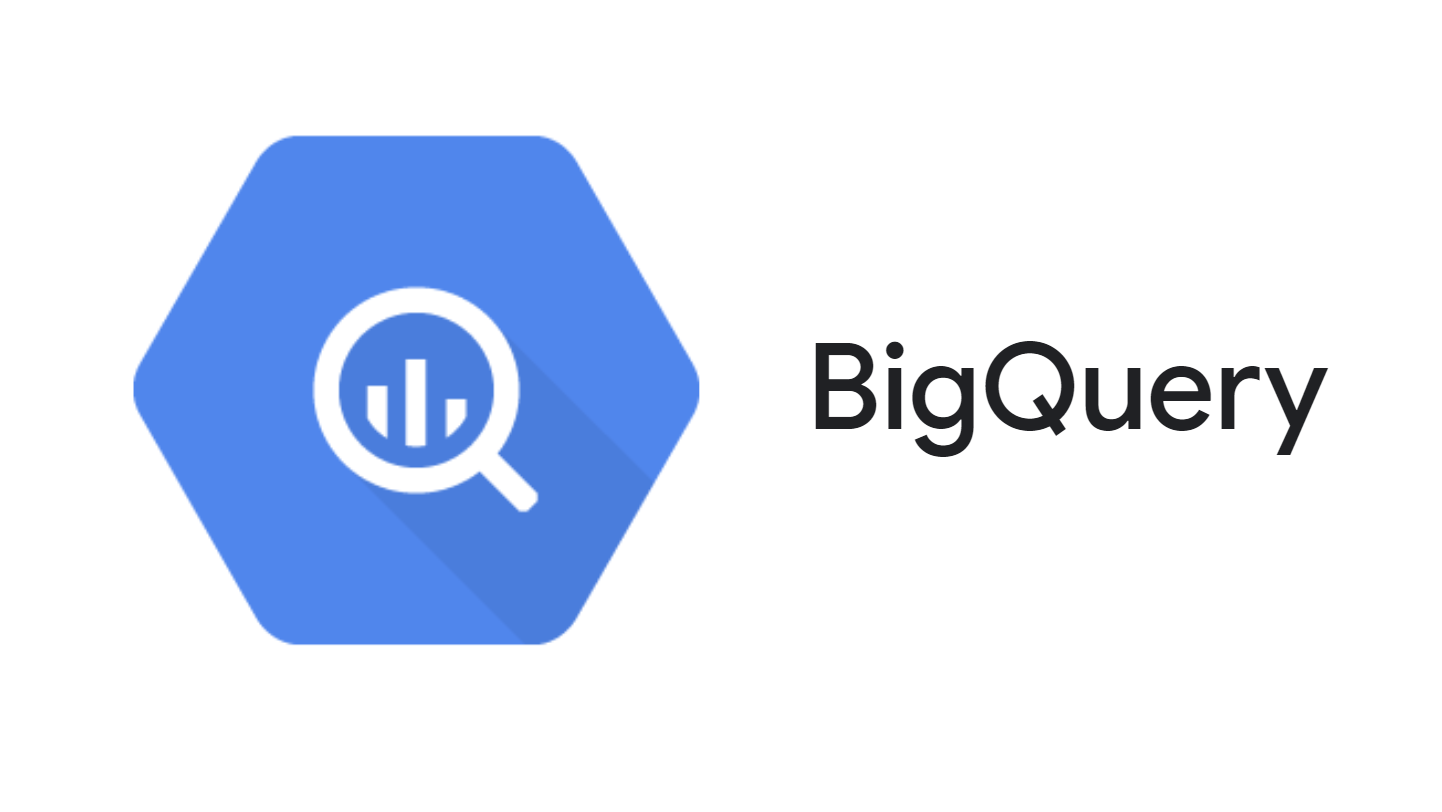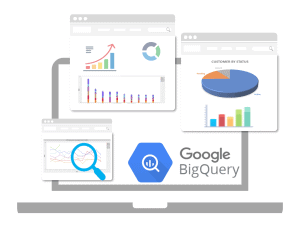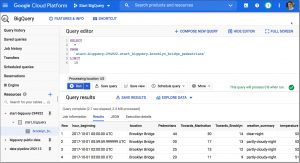The easy answer is that Google BigQuery is a cloud data warehouse which enables store and analyze large quantities of data quickly and efficiently.
But it is much more than that, Google BigQuery is a Google Cloud data warehouse of low cost, multi cloud, scalable, serverless and fully managed. Use built-in AI features, machine learning and BI (Business Intelligence) to obtain valuable information at scale. It also integrates analysis tools capable of processing petabytes of data in seconds; all this in a way profitable and adaptable to needs of each organization.
Google BigQuery is a fully managed solution that takes care of all the heavy lifting, which frees users to focus on the obtaining information valuable of your data.
With more and more channels and data sources, the need to customizable tools that allow them to be integrated and exploited in the same place is also increasing. Thanks to Google BigQuery, today it is possible.
Discover what it is, what advantages it offers and how it can help you Google BigQuery to extract valuable insights for your business.
1. What can you do with Google BigQuery?
In recent years, it has become clear that Traditional analytics cannot solve big data challenges, use appropriately large amounts of data either create predictive models. Google BigQuery, like other tools, now uses solvency to solve these challenges.
Unlike other GCP data stores, Google BigQuery was created specifically to improve data queries. This allows you to perform quick searches on structured query language (SQL) on large amounts of data, providing real-time investigations and results in seconds.
This solution Google Cloud is designed for gather multiple tools for facilitate storage, management and big data warehouse analysis. BigQuery can be used for a variety of applications, including:
1.1 Cloud Data Warehouse and Management to Drive Data-Driven Innovation with Google BigQuery
BigQuery allows you to perform SQL searches and query large amounts of data. These are analyzed in batches and streamed from data warehouses and spreadsheets.
One of the key features of BigQuery is separation of storage and processing. This allows you to scale independently if necessary.
BigQuery makes it easy to analyze data by running queries in memory thanks to the BigQuery BI Engine, an in-memory analysis service that can run queries with response times less than a second.
When it comes to BigQuery management, serverless data stores, centralize the processing of resources and data with identity and access management Google Cloud. The most notable points in this sense are:
- Manage and protect your resources, such as projects, data sets, and tables.
- Manage and optimize workloads, tasks, queries and capacity (reservations).
- Monitor resources such as quotas, jobs, processing usage, and troubleshoot error messages, billing issues, and quotas.
1.2 Creating reports with Google BigQuery
BigQuery allows you create reports, share the results with the entire organization and view dashboards quickly. Likewise, the use of the well-known SQL language facilitates the learning curve and opens the tool to people who already have this knowledge.
To view and create these reports, Looker, Google's star tool for data visualization, it connects to Google BigQuery to enable access to huge amounts of immediately useful data across the organization. For more details, We explain here what Looker is.
In short, Bigquery is a tool that gives you an agnostic vision of the situation, that takes the insights one step further, but that, above all, will allow you detect opportunities growth from knowledge generated by your data.
2. When to use Google BigQuery?
BigQuery's serverless architecture allows you to use SQL queries to analyze your data. You can store and analyze your data in BigQuery, or use BigQuery to evaluate it wherever it lives. BigQuery is a good option for organizations of all sizes who want to obtain valuable information from their data. However, it is especially suitable for organizations that:
Have large quantities of data to analyze. BigQuery can climb to accommodate any storage or processing needs.
They need to analyze data fast and efficient way. BigQuery can execute queries quickly, even on very large data sets.
They have no experience in data analysis. BigQuery is Easy to use, even for users without experience in data analysis.
We will mainly use BigQuery in cases like:
2.1 Migrate data warehouses to Google BigQuery
Meets current analytics requirements and easily scale your business. Simply migrate to the Enterprise Data Warehouse. Google Cloud. Simplify the migration path from Netezza, Oracle, Redshift, Teradata or Snowflake to BigQuery thanks to BigQuery Migration Service.
2.2 Incorporate all types of data from sources other than Google BigQuery
Facilitate analytics by bringing together data in BigQuery. data from different sources. You can upload data files from local sources, Google Drive, or Cloud Storage segments; use BigQuery Data Transfer Service or Cloud Data Fusion plugins; replicate data from relational databases with Datastream for BigQuery, or turn to Google's industry-leading data integration partners.
2.3 Event-based analysis
Respond to business events in real time with event-based analysis to gain a competitive advantage. Integrated streaming features automatically ingest streaming data and make it available to users immediately for them to make inquiries. This way, you can streamline your business and make business decisions based on the latest data. You can also use Data flow to enable fast and simplified streaming data processing pipelines.
2.4 Predict business outcomes with leading AI and machine learning features
Predictive analytics can be used to optimize operations, increase income and mitigate risks. BigQuery ML democratizes the use of machine learning by empowering data analysts to build and run models using available business intelligence tools and spreadsheets. Additionally, these analytics can guide business decision-making across the enterprise.
Google BigQuery has become one of the most used data analysis tools on the market, with a 13 % market share. Thanks to its versatility, ease of use, high storage capacity and serverless architecture, thousands of companies use it to convert data into information and make smarter decisions.
3. What type of database is Google BigQuery?
BigQuery stands out as a efficient data warehouse that uses the column storage format. In this approach, data is organized and stored by columns instead of rows, which provides notable advantages for data analysis by allowing quick and efficient execution of queries.
The BigQuery organizational structure is made up of projects, data sets, tables and jobs, providing a comprehensive framework to manage and structure data effectively.
3.1 Projects:
In the BigQuery hierarchy, the projects serve as fundamental containers for the data sets. Each project has its own storage space and establishes specific security policies. This division into projects makes organizing and managing data easy by assigning resources and permissions independently in each environment.
3.2 Data sets:
Data sets act as logical collections of tables within a project. Each data set has the ability to hold one or more tables, allowing for efficient organization and clear delineation of related sets of information. This structure facilitates management and navigation through logically grouped data.
3.3 Tables:
The tables represent the fundamental units of data storage in BigQuery. Each table contains a specific set of related data, making it simpler to manipulate and analyze specific information. This granular organization facilitates identification and recovery of accurate data when performing queries and analysis.
3.4 Jobs:
The works constitute processes executed in BigQuery and can take various forms, such as queries, data loads, or data exports. These processes represent specific actions that manipulate the data stored in tables, allowing dynamic and effective interaction with the information contained in the data warehouse. Executing jobs is key to carrying out analytical, loading or export tasks, providing flexibility and versatility in data management.
BigQuery is not only distinguished by its efficient column storage format, but also by its hierarchical organizational structure that facilitates the management, analysis and manipulation of large-scale data in an effective and structured manner.
4. Google BigQuery Highlights
Google BigQuery stands out for its features and functionalities that position it as a powerful tool for large-scale data analysis. Here are some BigQuery highlights:
4.1 Multicloud Analysis and Sharing:
BigQuery Omni offers a managed multi-cloud analytics solution, enabling secure and cost-effective analysis of data from multiple clouds.
BigQuery Analytics Hub facilitates the secure sharing of data resources internally and externally, improving analysis with commercial, public and Google data sets.
Enables the creation and management of data clean rooms for privacy-focused measurements, collaboration, and data sharing across organizations without the need to transfer or copy data.
4.2 Real-Time Analysis with Streaming Data:
BigQuery incorporates built-in functions for automatic ingestion of streaming data, available immediately for consultation.
Offers native integrations with streaming products like Dataflow.
Use BigQuery BI Engine for interactive analysis with a response time of less than 1 second and high concurrency, optimizing performance and reducing costs with materialized views.
4.3 Data Unification, Management and Governance:
BigQuery allows you to query data of all types: structured, semi-structured and unstructured.
Use BigLake to examine and unify various types of data and create advanced models.
Dataplex centralizes and controls data from data lakes, data warehouses, and data marts, providing access to trusted data with consistent controls.
4.4 Integrated Business Intelligence (BI):
Employ integrated business intelligence with Looker Studio to create and share valuable information with ease.
BigQuery Studio offers a unified interface for data professionals with diverse skills, simplifying analytical workflows, from ingestion to visualization to building machine learning models.
4.5 Duet AI in BigQuery:
Duet AI provides contextual assistance for typing SQL and Python, suggesting functions and code blocks automatically.
Chat support allows you to get real-time instructions, reducing the need to search for documentation.
4.6 Integrated Machine Learning:
BigQuery ML enables scientists and analysts to create and use machine learning models directly in BigQuery with simple SQL.
Export models to Vertex AI or your own service layer for online predictions.
4.7 Governance and Data Security:
Integration with security and privacy services Google Cloud provides detailed security and governance controls, even at the column and row level.
Data is encrypted both at rest and in transit by default.
4.8 Geospatial Analytics:
BigQuery geospatial analytics combines its serverless architecture with native geospatial analysis support, facilitating analytical workflows with location data.
Simplify analysis, query spatial data in new ways, and explore new lines of business with support for points, lines, and polygons in common geospatial data formats.
5. How to apply Google BigQuery to optimize all its benefits?
To maximize all the benefits of Google BigQuery, it is important to keep the following aspects in mind:
Efficient data layout: Data must be structured in a way that is efficient for analysis, using a column-based storage format and eliminating duplicates.
Efficiently use built-in functions: BigQuery provides a wide variety of built-in features that make it easy for users to get valuable insights from their data. The effective use of these functions is essential.
Cost management: BigQuery bills only for the data stored and processed. It is crucial to manage the costs associated with BigQuery to ensure you get the maximum possible value.
Definition of requirements: It is essential to establish the organization's data requirements before implementing BigQuery. This will ensure that the platform is used for appropriate and goal-aligned applications.
Integration with external systems: BigQuery easily integrates with other systems, such as CRM, ERP, and marketing platforms. This simplifies the collection and analysis of data from various sources.
User training: Providing training to users on how to use BigQuery effectively is crucial. This will ensure that users can get the most out of the solution and achieve optimal results in their operations.
Google BigQuery is a powerful and cost-effective data analytics solution that can be used for a variety of applications. As we have seen in this article, BigQuery has helped facilitate access to information in a secure and scalable way. Solutions to complex business decisions will be made based on analytical data.
This tool allows companies of all sizes to use their data easy, economical, flexible and scalable way without having to worry about hardware or software.
This allows you to use all this information to make informed decisions, reduce the chances of error, and focus on what matters most, such as enabling predictive statistics. Takes a 360-degree view to develop customized products, improve operational efficiency, and understand customer needs.
In uCloud, We are a global partner of Google Cloud and we can help you. Our experience and knowledge of BigQuery and other Google Cloud tools allow us to do this. Are you ready for the next step?








